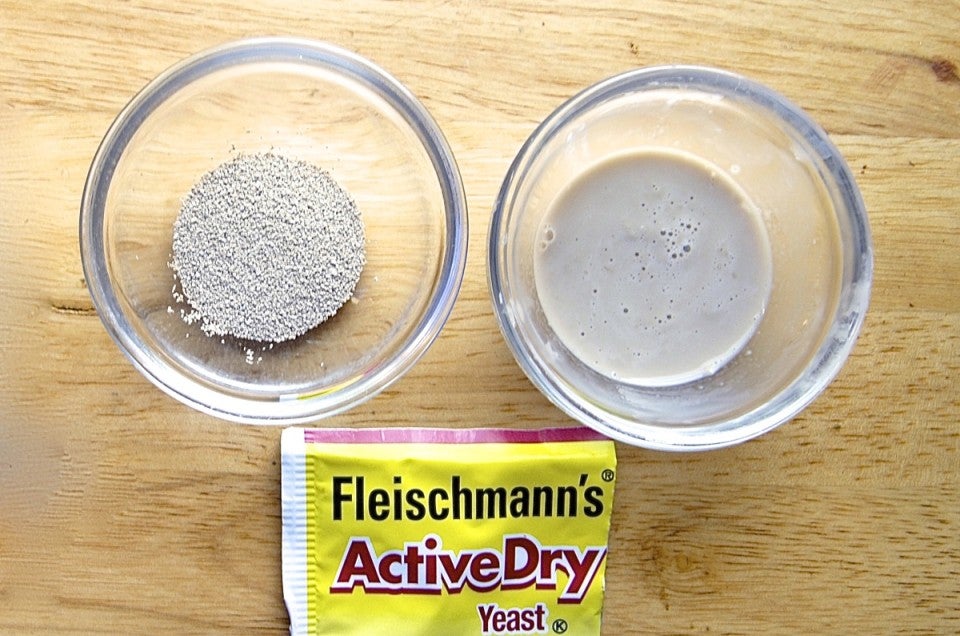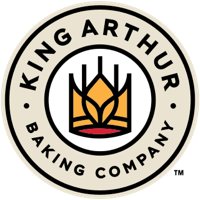


Is it really necessary to dissolve active dry yeast before using it in bread? Inquiring bread bakers want to know!
You may have heard over the past year or so that active dry yeast (ADY) has been reformulated into a smaller particle size, and can now be used without dissolving it first – as had always been the requirement.
Note: Dissolving yeast and proofing yeast are two distinct processes. First we'll cover dissolving; see the end of this post for information on when to proof yeast.
Really – you don't need to dissolve ADY in lukewarm water before using it?
Let's put it to the test.
On the left, dough made with undissolved ADY – yeast simply added along with the other dry ingredients. On the right, dough made with dissolved yeast.
An hour later, the dough has risen. I don't see any difference – do you?
Let's shape some dinner rolls.
I decided to bake the rolls all in one pan, to make sure neither pan nor placement in the oven would affect their rise. Top row are the rolls using dissolved yeast; bottom row, undissolved. (If you're really tracking this, the roll at the left in the middle row uses dissolved yeast; middle roll at right, undissolved.)
The rolls rise for an hour. I still don't see any difference.
Nor is there any difference once they're baked.
So, inquiring bakers – inquire no more! You don't need to dissolve active dry yeast in lukewarm water before using it. (Even though it still says you should dissolve it on the back of the yeast packet, if you buy your yeast in packets.)
Now, what about that "proofing" stuff?
Proofing yeast – or as it used to be called, "proving" yeast – serves as proof that your yeast is alive and active. And how, exactly, do you do this?
Well, if you're using a typical 1/4-ounce packet of yeast, just follow the directions on the back: dissolve the contents of the packet in 1/4 cup warm water with 1 teaspoon sugar. After 10 minutes, the mixture should be bubbly. Once you've proved the yeast is alive, go ahead and add it to your recipe – reducing the water in the recipe by 1/4 cup.
I actually never proof yeast. I use SAF instant, purchased from our Web site; I know it's always fresh and vigorous.
But I did put a packet of Fleischmann's to the test.
Yeast dissolved in warm water with sugar on the left; same yeast, 20 minutes later. It only had a few small bubbles after 10 minutes, but 20 minutes did the trick.
Were you expecting foamy? Nah. But it's definitely puffy.
And that's proof enough the yeast is alive.
So, bottom line: dissolve yeast in warm water with a bit of sugar to prove that it's alive. This shouldn't really be necessary if the yeast isn't close to its expiration date; and if you purchased it from a store with decent turnover. However, if you have any doubts about your yeast being good, go ahead and proof it.
But dissolve active dry yeast before using it – just because? No need. Add ADY to the bowl right along with the rest of the dry ingredients; your bread will rise just fine.
P.S. My fellow blogger, MaryJane, said I should let you know that if you want to dissolve your active dry yeast before using it, go right ahead. She's right: no problem with dissolving it, if that's the way you've always done it and want to continue.







September 28, 2024 at 2:06pm
Hi! I'm a beginner baker here!
I activated the yeast in warm water and noticed foam on top and some water in the bottom of the jar after 10 minutes. Should I remove that water or pour it all into the recipe?
Thanks
October 5, 2024 at 3:41pm
In reply to Hi! I'm a beginner baker… by Mónica (not verified)
Hi Monica, typically you would want to proof the yeast in the water that is already called for in the recipe. That way you are not adding extra water to the dough. Hope this helps!
August 10, 2024 at 8:03am
It would be helpful to mention that machine-mixing is assumed in this writeup as using ADY in a handmix dough without first dissolving it in water is less likely to be successful.
August 10, 2024 at 12:35pm
In reply to It would be helpful to… by Jon Stancil (not verified)
Hi Jon, actually we've found that the ADY will activate even when hand mixing and kneading. For more information about yeast, check out this article.
August 6, 2024 at 1:47pm
You don't mention what temperature the water used in the recipe was. This makes a huge difference. If you use 95-115 degree Fahrenheit water it doesn't make a difference.
Some people use cold tap water and this will definitely not work for ADY. You may get some activity but it will be greatly improved by using warm water or dissolving the yeast first.
August 6, 2024 at 3:05pm
In reply to You don't mention what… by Steve (not verified)
Hi Steve, we classify lukewarm water as 98F-110F. You can find this info on our Recipe Success Guide. Hope this helps!
February 6, 2024 at 9:42am
I didn't dissolve my yeast and did have variable results, but my bread did rise. It just rose more with bloomed yeast. Martin's recipe for oatmeal bread said to let the bread proof until it rises an inch and a half over the top of the loaf pan; that didn't happen until I used bloomed yeast. I have a 2lb. bag of Red Star active dry yeast purchased from Costco during the pandemic that I am still going through!
February 10, 2024 at 1:57pm
In reply to I didn't dissolve my yeast… by Bonnie (not verified)
Hi Bonnie, by all means stick with what works best for you! It may be that your older active dry yeast responds better when dissolved, and it won't hurt to check that it's still nice and active before proceeding with the recipe.
November 17, 2023 at 12:59pm
i use Lesaffre red yeast, and since it does not require proofing any more, what do i do with the liquid used to proof it? do i add it to the rest of the ingredients, or leave it out? the last time i added the liquid to the recipe, the dough became too sticky to handle, and i addd more flour, but then it made the product dry and harder than usual. Help! thank you
November 18, 2023 at 11:31am
In reply to i use Lesaffre red yeast, … by Marietta (not verified)
Hi Marietta! We recommend leaving the liquid called for on the package of yeast out of the recipe and only using the liquid called for within the recipe. This would be true whether you are using instant or active yeast (though the active yeast you add to the liquid called for in the recipe and the instant can be added to the dry ingredients). Happy baking!
Pagination